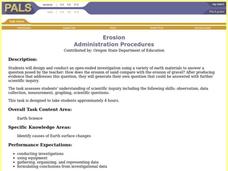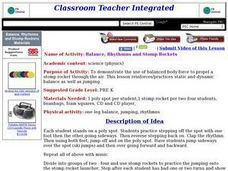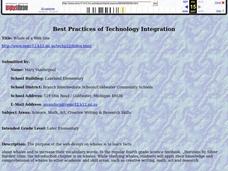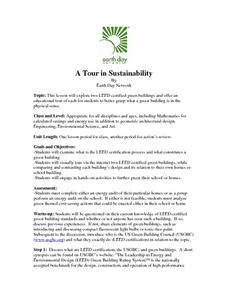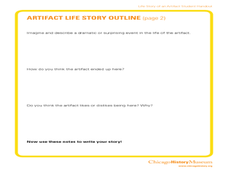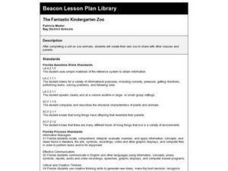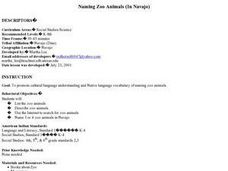Curated OER
Erosion
Young scholars design and conduct an open-ended investigation using a variety of earth materials to answer a questions posed by the teacher: How does the erosion of sand compare with the erosion of gravel? After producing evidence that...
Curated OER
Are Enzymes Specific for Their Substrates?
Students discover enzyme to substrate specificity. The experiment uses samples of glucose and lactose in combination with the enzyme lactase. Students observe the reaction between the lactose and the lactase; the lack of a reaction...
Curated OER
Balance, Rhythmns and Stomp Rockets
Students practice stepping and jumping, using specified foot action, in rhythm. In groups, they practice jumping onto stomp rocket launchers and demonstrate how to increase the distance by raising the angle of the launcher. After each...
Curated OER
Whale of a Web Site
Students compare and contrast differences and likeness of whales/fish and toothed/baleen whales and discuss what they know about whales and what they would like to study about whales. They then describe the characteristics of a mammal.
Curated OER
Community Service
Studen collect trash around the community with trash bag and gloves. They recognize and describe ways that some materials
Curated OER
A Tour in Sustainability
Learners explore two LEED certified green buildings. They examine what is the LEED certification process and what constitutes a green building. They tour via the internet two LEED certified green buildings, while comparing and...
Curated OER
Hold on Tight!
Students explain how manufactured products depend on its function for a purpose. In this sticky tape lesson plan students test the strength of different tapes, take measurements and record data.
Curated OER
The Akron Global Polymer Academy Lesson Plan Format
Students identify types of garbage that will decompose quickly and the ones that do not. In this decomposing instructional activity students observe and record the photo degrading of six pack rings.
Curated OER
Life Story of an Artifact
Students write about an artifact that they are studying. In this artifacts lesson plan, students analyze details of the artifact and answer short answer questions about it.
Curated OER
Moving Objects
Second graders investigate pushing and pulling. In this lesson on how objects move, 2nd graders experiment with marbles to see how one marble can be moved by getting hit by another marble.
Curated OER
Habitats
First graders investigate animal habitats. In this habitats lesson, 1st graders visit the woods to identify examples of food, water, and shelter that animals use to survive. Students complete a worksheet.
Curated OER
Planets
First graders study the planets in the solar system. In this planets lesson, 1st graders read Planets, then create a mobile containing all of the planets in the correct order. Students will label the planets with descriptive words.
Curated OER
Interview Wildlife
Fifth graders study wildlife. In this environment lesson, 5th graders choose a wild animal, write questions to interview the animal if they could, find the answers to these questions by doing research, and write a newspaper article using...
Curated OER
It's not just pretty - it's a survival method!
First graders write explanations for why certain animals can only live in certain environments. In this animal survival lesson plan, 1st graders take pictures of animals and place them into the right environment after a instructional...
Curated OER
Investigating Crickets and Their Body Parts
Second graders investigate the body of a cricket. In this biology lesson students use tools to gain information about the insect the cricket. Students observe and identify features and describe how these features help the cricket live in...
Curated OER
What Foods Contain Products from the Ocean
Fifth graders learn about foods from the ocean. In this ocean products activity, 5th graders brainstorm what foods come from the ocean, fill in a Venn Diagram comparing alginates, carrageenans and beta carotenes. Students make a list...
Curated OER
Observing Osmosis in a Chicken Egg
Tenth graders develop a hypothesis and explain what they observed on an activity. In this investigative lesson students observe osmosis and report their data using a graph.
Curated OER
Designing Future Houses
Students discuss houses of the future and imagine future house designs. They create a floor plan, architectural drawing, and write a short description about their future house.
Curated OER
The Fantastic Kindergarten Zoo
First graders create their own zoo to share with other classes and parents. Groups create displays for the animals. Have each group brainstorm how they create a display for their animal.
Curated OER
Creating My Personal Animal ABC Book
Students conduct Internet research on various animals. They write and create an Animal ABC book, including pictures of each animal, and each animal's phyla and class, to present to a young child.
Curated OER
Let's Forecast the Weather!
Students discuss weather and how it is forcast on the news. They set up a "news room" and create their own sentences with a forecast and advice for those watching based on the forecast. These sentences are used as students role play weather
Curated OER
Naming Zoo Animals (In Navajo)
Students investigate zoo animals and name various zoo animals in Navajo. They take a field trip to the zoo, take digital pictures of various animals, conduct research, and name each animal in Navajo.
Curated OER
In Outer Space
Students use the internet to gather information on the solar system. They identify the discoverer and unique characteristics of each planet. They compare and contrast each planet based on size, mass, and distance from the sun. They...
Curated OER
The Nature Of Dissolving Processes
Young scholars examine the rule of "like dissolves like." They define and describe solutions and solubility models on molecular liquids, ionic solids, and molecular solids.


